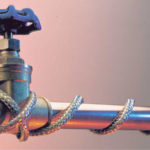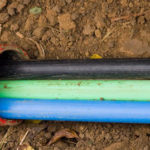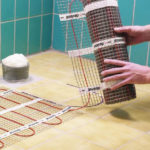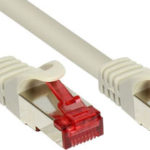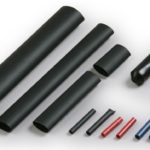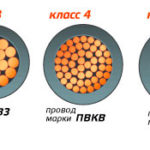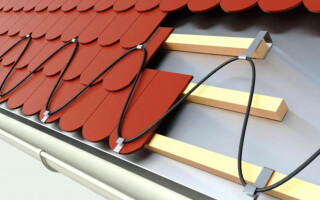Late fall and early spring is a time of freezing of roofs and the appearance of icicles, which when fallen cause injury to people and animals passing by. Roof heating in this case is the way out of this situation. There is no accumulation of ice and snow on the heated roof, they melt and escape through the gutters and pipes.
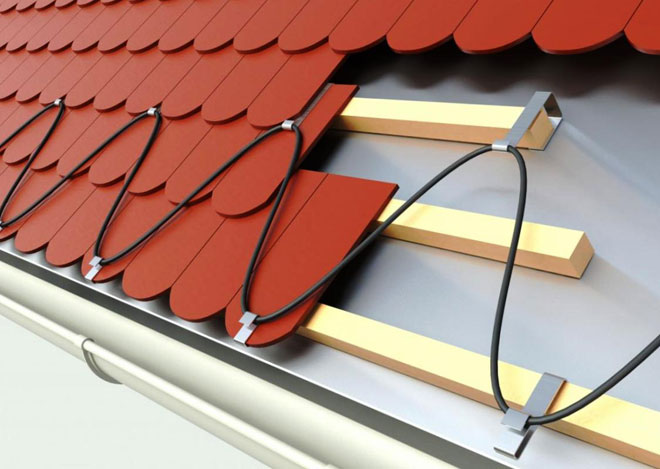
Contents
Peculiarities of the roof heating system
Whether you need to heat the roof - a complex issue. On most of Russia the winters are cold. Large masses of snow accumulate on the roof. When the temperature rises, they thaw, and at night they freeze again. These processes gradually lead to the destruction of systems that provide drainage, as well as damage to the surface of the roofing material. Not only the roofs suffer, but also the vehicles below.
To avoid the formation of ice on the roof, a path is cleared for the flow of water into the drainage system. For this purpose, there is a flat roof heating system, which is also used on steep slopes. If you perform a heated roof, it will not be enough. Water will flow during the day into the gutters and pipes, then freeze there. Ice its weight will break fasteners and pipes or parts of them will collapse down. Therefore, the main feature is that the heating elements are laid:
- On the eaves of the roof;
- At the bottom of gutters;
- Inside gutters and downspouts;
- At the joints of roof surfaces.
There are few methods for heating. Warm and cold roof heating is carried out. Consider each option in detail.
Heating a cold roof.
A cold roof is laid on a roof with well ventilated and thermally insulated. Such structures are found above non-residential attics. Thermal insulation does not allow warm air to escape into the street, accumulated snow does not melt, frost does not form. Roof heating consists of laying a heating conductor. It is stretched inside the gutters and along the bottom inside the gutters. Power cable starts with small values (20 watts) and goes up to 70 W/m. This is enough for the formation and drainage of melt water.
How to heat a warm roof
Warm roof does not have high-quality insulation. Heat from the attic travels outside. In the evening the ambient temperature drops and the water freezes. It also freezes during the day when it gets on the cold parts of the roof. The result is the formation of ice, which falls down and brings a lot of trouble for the residents of the house. Therefore, to eliminate icing on the roof edges are heated. To do this, the heating wire is laid along the edge in loops 30-50 cm wide. For 1 m² of area have a cable with a power of 250 watts.
Gutter heating
Now let's answer the question: whether the gutter heating is necessary. For electric heating there are systems, based on a heating element in the form of a cable. The remaining nodes and parts:
- distribution unit;
- sensors;
- controller;
- control panel.
The distribution block combines power and heating wires. It consists of a signal wire that connects the unit to the sensors, couplings to seal the parts, and a mounting box. The unit is often installed on the roof. It is protected from moisture. Sensors indicate the presence or absence of water, ambient air temperature and precipitation. They are located in the gutters, on the roof. The collected data goes to the controller, which turns on or off the heating system.
Control board ensures the safe operation of the system. To equip it, you need to buy a three-phase circuit breaker, contactor and alarm lamp. To install and secure the heating cable requires fasteners in the form of rivets, screws or nails, as well as heat shrink tubing and installation tape.
How to choose a right heating cable
The main element of roof heating - a cable. It comes in resistive and self-regulating. You must choose it correctly and thoughtfully, considering all the positive and negative sides.
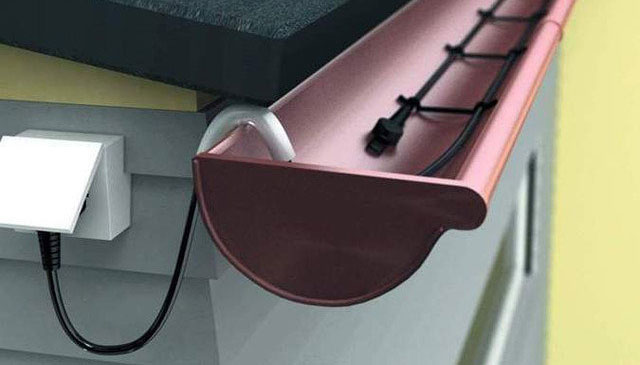
Resistive type cable
This material is simple in its operation. It has a high-resistance conductive core inside. When current flows, the inner wire heats up and gives the heat received first to the insulation, then to the roofing material. Such a system does not need large financial costs and is easy to use. The advantages of the cable:
- no starting currents;
- constant power;
- low cost.
Constant power requires a thermostat in the circuit to turn the heating temperature up or down.

Self-regulating cable
Self-regulating cable is arranged in a more complex way. It has two wires inside, surrounded by a matrix. It takes into account the temperature of the ambient air or snow and adjusts the resistance of the inner cores of the cable. In warm weather the cable gets less heat, in cold weather it gets more heat. Advantages of the cable:
- no installation of control devices is required;
- no need for temperature controllers and detectors;
- the system does not overheat;
- cable can be cut into pieces of length from 20 cm.
Self-regulating cable can be crossed and twisted during installation. This does not affect its performance.
The disadvantages include the cost. Its price is several times higher than its resistive counterpart. But in operation it will cost less. The second disadvantage is the gradual failure of the self-regulating matrix and the entire cable.
How to calculate the heating system
Before installing a roof and gutter heating system, you need to calculate it. Then the de-icing of the roof will work without interruption. Specialists recommend choosing a cable for roofs with a capacity of 25 W/m. It is used in different areas of construction: for the construction of underfloor heating, low-power heaters. Maximum load develops on the roof during the 11-33% of the time that falls on the cold. In some regions, this period from November to March, in others - a shorter time.
For calculations we need data on the gutter: the length of gutters, downspouts and their diameters. The total length of horizontal sections multiplied by 2 and you get the length of the desired cable. The cable length for vertical pipes is equal to their length. Cable lengths for vertical and horizontal sections are added and multiplied by 25. This is how the power of the cable is calculated. This is a rough calculation, for more accurate invite a specialist.
How to lay a heating cable
For proper operation of the de-icing system heating elements should be placed in each area of the roof where icing appears. In valleys it is extended by at least one meter. Flat roof surfaces are heated in front of the gutter so that the melt water can flow directly into the gutter without obstruction. On the edge of the eaves heating wire is laid in a snaking pattern with a pitch of 35-40 cm. To heat the gutters, the laying is done inside them. Most often two strands are needed. Inside the water pipes one heating thread is placed vertically.
Installation work
Installation of roof heating is performed in several stages. First, the areas of laying the wires are outlined, taking into account the twists and complexities. On tight turns, the cable is cut into small pieces and connected using couplings.
Marking the lines
Before making the markings, you need to carefully inspect the substrate. If it has any protrusions and sharp corners, you need to get rid of them. This is not always possible, then the cable is cut into pieces and connected the pieces with couplings.
Fixing the heating cable
It is not enough to put the heaters on the prepared places. They still need to be firmly fastened. Inside the pipe, attachment is made with a mounting tape. The same method is used for wiring in a gutter. It is necessary to choose a tape of maximum strength. Resistive conductor is fastened every 25 cm, self-regulating - half as often, every 50 cm. Tape strips are reinforced with rivets. They are replaced by installation foam.
Inside the downpipes the cable is placed in heat shrink tubing. Fragments longer than 6 m are still attached using a metal rope. Cable installation on the roof is made with mounting tape and foam. Rivets are not suitable here because they leave holes. After a while, the roof will begin to leak.
Installing installation boxes and sensors
Under the installation of the box should choose a suitable place. The box itself is tested in order to measure the insulation resistance. After the box is installed, wires are laid, sensors are installed and connected with insulating sleeves. It is recommended to install the sensors in the places of the greatest accumulation of precipitation. Electrical wires are used to connect them to the controller. In houses with big roofs, the sensors are combined into groups, and then each of them is connected to the controller.
Mounting the automation in the switchboard
Control of the heating system as part of the controller and its protection is often installed in the panel, which is located inside the premises. The controller is equipped with terminals to which wires and heating elements are connected. All wires and appliances are tested. If any problems are detected, they must be corrected. The main thing is to check the functionality of the protection group. If no problems are detected, connect the thermostat and start the system.
Typical installation mistakes
Performing installation of heating, it is difficult not to make mistakes. Experienced professionals note the following among them:
- Ignoring the peculiarities of the roof;
- mistakes made in the attachment of the working cable;
- The use of tape of the wrong type;
- The use of plastic clamps;
- Suspending a heating element in the pipe without a metal cable;
- laying wires on the roof that were not designed for this purpose.
As a result of ignoring the features on some part of the roof, the growth of ice continues. The construction of the roof is at times something unthinkable. Plastic clamps deteriorate after a few months. Long wires without a cable break under the weight of the ice that has built up on them. Electric roof heating ceases to function at this point.
Practice shows the need for heating roofs and gutters to ensure proper thawing and drainage of melt water. Otherwise, falling blocks of ice and snow cause numerous injuries to people every year and damage cars parked in the yard. You can install the system with your own hands. To do this, you need to have a ready-made power calculation. The cost of the system will justify itself in the shortest time.
Related articles:
